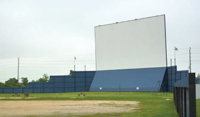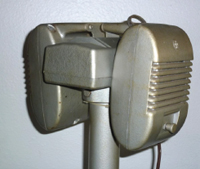
Projector buildings housed a profitable concession stand and restrooms a
short walk from the car.
A LITTLE PIECE OF HISTORY | By Joan Frances –
Anyone who was born in the 1940s remembers the good old days of the drive-in theater. Weekends were highly anticipated, and lines of automobiles came early to get the best parking spot. The car was a comfortable change from traditional movie theater seats. When the sun went down and darkness set in, the big screen lights captured the movie in a larger than life venue. Three large speakers were mounted near the screen, and snack bars offered abundant food for the whole family. Those were the days before high-tech surround sound and visual effects, but it didn’t matter. The drive-in movie was the place to be on a weekend night.

This 66 foot screen and lot accommodates up to 400 cars.
Richard Hollingshead, a young entrepreneur from Camden, New Jersey, was a sales manager at his dad’s Whiz Auto Products. Hollingshead loved cars and movies and came up with the concept of open-air movies viewed from the comfort of an automobile. After experimenting in his own driveway, Hollingshead mounted a 1928 Kodak projector to the hood of his car and placed a radio behind a sheet he used as a screen. He devised a plan for parking and tested ways to guard against inclement weather.
On May 16, 1933, Hollingshead received a patent and opened Park-In Theaters, Inc. With an investment of $30,000, the first drive-in opened on June 6th. The price of admission was 25 cents per car and 25 cents per person.

These speakers with adjustable volume were hung on the inside window of each car for sound quality at drive-in theaters.
After World War II, drive-in theaters spread across the country. In-car speakers were designed to replace the large bullhorn speakers at the screen, allowing patrons in cars at the back of the site to hear the movie. By the late 1940s, many drive-ins added playgrounds and train rides to make the event more family friendly. Concession stands set up cafeteria-style food to feed a large crowd in the 10 minute intermission that featured cartoons and a clock that counted down the time until the second feature. By 1958, there were over 4,000 drive-in theaters in the United States. The appeal of the drive-in theater was the casual and convenient alternative to an indoor, uncomfortable and costly movie theater.

This 1950s station wagon held six passengers for a bargain admission price of 70 cents per carload.
The first drive-in theater in Fort Bend was the Twin City Drive-In at Avenue H in Rosenberg. Opening in 1950, it was well-equipped with a large playground for the “kiddies,” and mosquitoes were controlled nightly. Mart Cole, owner of the famous Cole Theater in Rosenberg, Cole in Halletsville, The Lamar in Richmond, The Palms in Sugar Land, and The Grand and Sunset Drive-In in Yoakum, owned and opened the drive-in year round. On Tuesday and Wednesday nights, 70 cents would admit a whole carload of patrons. The snack bar invited guests to a delicious meal of hot dogs, hamburgers and fried chicken. Unfortunately, Twin City Drive-in closed in 1983, and the land was redeveloped. Today, there are less than 500 drive-ins operating in the country.
So, what led to the demise of this wonderful concept of family entertainment? Some speculate that one reason was the introduction of daylight savings time. Parents didn’t want to bring their kids to a movie that did not start until 10 pm. In addition, movie operators switched the genre to adult or occult films, which lost family appeal. With the inception of cable television and VCRs in the 1970s and 80s, people stayed home to watch movies.
However, drive-in theaters are making a comeback. A whole new generation is discovering the appeal of outdoor viewing. With innovative technology, the drive-in movies of tomorrow will help keep this American tradition alive.